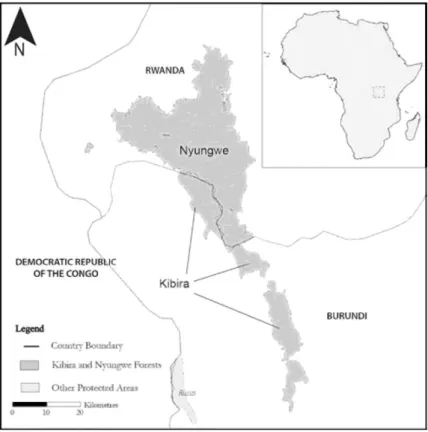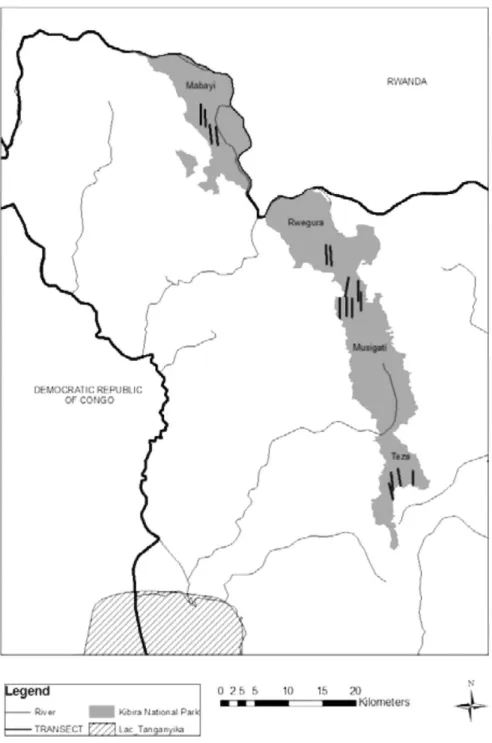Chimpanzee (Pan troglodytes schweinfurthii) Population Density and
Abundance in Kibira National Park, Burundi
Dismas Hakizimana1, 2 & Marie-Claude Huynen1
1 Department of Behavioral Ecology, University of Liege, Belgium 2 Department of Biology, University of Burundi, Burundi
INTRODUCTION
The eastern chimpanzee, Pan troglodytes schweinfurthii, is an "endangered" chimpanzee subspecies of global conservation concern, living at low density (less than 1 individual/km2) in most of its range (Keele et al. 2006; Plumptre et al. 2011) in eastern Africa. As chimpanzees have a relatively low reproductive rate (Caldecott & Miles 2009), their ability to recover from population decline is limited. Documenting the extent and severity of such decline events, as well as targeting adequate conservation plans, requires reliable baseline data on density estimates of great apes (Oates 1996) in area of occurrence.
In Burundi, eastern chimpanzees are mostly reported to occur from the North-Western Kibira National Park (KNP), which is contiguous with Nyungwe National Park (NNP) in Rwanda, both forming one continuous landscape (Figure 1). Unfortunately, during the 1993-2007 conflict, KNP was permanently occupied by armed groups and its biodiversity has been extensively destroyed by armed gangs' progression, bush fires, poaching, illegal logging and clearing for agriculture. The purposes of our survey were to provide reliable information on chimpanzee abundance in the KNP and to identify sectors where conservation efforts should be prioritized.
Figure 1. Location of Kibira and Nyungwe National parks.
METHODS Study area
KNP is located in the North-West of Burundi on the Congo-Nile Divide, between 2°36'52" and 3°17'08" south latitude and between 29°13'31" and 29°39'09" east longitude. It covers 400 km2 of montane forest, lying from 1,600 to 2,666 m of altitude (Arbomer 1996). Relief, more marked on the western side, is characterized by steep slopes on both sides of the Congo Nile Divide. The park is shaped into four sectors, from south to north: Teza, Musigati, Rwegura and Mabayi, covering respectively 57.94 km2, 154.24 km2, 124.23 km2 and 63.59 km2 (Figure 2).
Data collection
Between September 2011 and February 2013, we repeatedly surveyed sixteen linear transects of 3 km each, to census chimpanzee populations density and abundance using the marked nest count method (Kouakou et al. 2009). The inter-visit interval was of three weeks, and each transect was censused eighteen times over the entire study period.
We walked along the census transects with two field assistants at an average speed of 0.7 km per hour to ensure detection of all chimpanzee nests. During the first walk, we marked all existing nests with a piece of flagging tape attached to nesting trees (Plumptre & Reynolds 1996). During the following visits, only new nests built since the last passage were recorded and marked. For each nest we systematically recorded the perpendicular distance to transect line, GPS position and altitude.
Data analysis
To estimate chimpanzee density for the whole park, we combined nest counts from all transects. We used the DISTANCE software (version 6.0) (Thomas et al. 2009) to obtain chimpanzee density estimates. According to Buckland et al. (2001), 5% of observations occurring at the furthest distance from transect were truncated. Four mathematical key (Uniform, Half-normal, Hazard rate and Negative exponential) modeling nest detection function were tested, in combination with 3 adjustments terms (Cosine, Simple polynomial and Hermite polynomial). We calculated Akaike's Information Criterion (AIC) for each model and the best model had a lowest AIC value (Buckland et al. 2001). Nest-building chimpanzee density was estimated by following Plumptre & Reynolds (1996).
RESULTS
A total of 864 km of line transects were surveyed and we recorded 471 new nests of chimpanzees, at an altitude ranging between 1,956 - 2,552 m.
Half-normal key with simple polynomial adjustment was the model fitting the best our distribution of perpendicular distances. Chimpanzee density estimate in the entire park was 0.509 individual/km2 (95% CL: 0.305 - 0.847, CV: 24.37%), which corresponds to a total population size of 204 weaned individuals (95% CL: 122 - 339). Chimpanzee densities for each sector of the park are given in Table 1.
Mabayi has an important chimpanzee density compared with other sectors. Its chimpanzee density is four times greater than Rwegura, six times greater than Musigati and three times greater than Teza.
Table 1. Population density and abundance, with confidence limits (CL) of nest-building chimpanzees in the four
sectors composing the Kibira National Park.
Location Area (km2) Estimated
density 95% CL Number of individuals 95% CL Teza 57.94 0.352 0.159-0.778 20 9-45 Musigati 154.24 0.190 0.093-0.390 29 14-60 Rwegura 124.23 0.293 0.106-0.812 36 13-101 Mabayi 63.59 1.172 0.744-1.847 75 47-117 Entire park 400 0.509 0.305-0.847 204 122-339 DISCUSSION
Chimpanzee density and abundance in the Kibira National Park
Our results are markedly lower than previous estimates by Barakabuye et al. (2007) who reported a density estimate of 0.984 individual/km2 (95% CL: 0.601 - 1.612), and a total population of 394 chimpanzees (95% CL: 240 - 645). This discrepancy is likely due to different sampling efforts. First, our estimated chimpanzee density is based on 18 months of survey while Barakabuye et al. (2007) survey only covered a three-month period. Short-time survey provides less reliable information, especially for P. troglodytes known to use large home
ranges (Johns & Skorupa 1987). In order to take into account seasonal variations in behavior, Baldwin et al. (1982) suggested a minimum of one year for such survey. Second, we applied an equal sampling effort throughout the four sectors of the KNP while Barakabuye et al. (2007) placed half of their transect lines in the sole Mabayi sector, which is most likely the one harboring the largest chimpanzee population. Extrapolation of their estimates to the entire park logically leads to an overestimation (Buckland et al. 2010). The longer time we devoted to data collection and the use of the marked nest count method leads us to say that our estimate would be more representative of the KNP.
The lower estimate of the chimpanzee population size in our study is in logical agreement with the region recent history. Biodiversity of the KNP suffered from several years of armed conflict. Armed groups practiced poaching and subsistence hunting. As chimpanzee is the largest animal of the park, it is evident that it was a war victim.
Comparison within sectors
Determining the variation of distribution of chimpanzees between given areas is very important for researchers and conservationists (Morgan et al. 2006). Our results show that chimpanzees are more abundant in the Mabayi sector, directly contiguous with the NNP in Rwanda. This might be because this area was less affected by armed conflicts compared to Teza and Musigati which were permanently occupied by rebels. Another reason might be that some tree species primordial as food sources and nest supports for chimpanzees, are only or more represented in this part of the park (Hakizimana, unpublished data).
Comparison within Kibira and Nyungwe National Parks
Kibira and Nyungwe are two contiguous national parks, but Nyungwe (1,080 km2) is twice larger than Kibira (400 km2). Barakabuye et al. (2007) found a chimpanzee density much higher in the Kibira compared to Nyungwe (0.984 individuals/km2, 394 individuals in Kibira; 0.353 individuals/km2, 382 individuals in Nyungwe). This is a puzzling difference, as Nyungwe is known to have been better protected (Barakabuye et al. 2007). If confirmed, the highest chimpanzee density they found in Kibira might result from the high density of tree species on which chimpanzees rely heavily (Balcomb et al. 2000; Tweheyo et al. 2004). To ensure a robust comparison and solve ambiguities, a rigorous study should be led by the same team in both parks focusing on census and resource availability.
Conservation implications
Intensive effort must be devoted to the chimpanzee's long-term conservation throughout their range. Research on the species is still young in Burundi compared to neighboring countries. Therefore, it is very important to implement a monitoring program of chimpanzee populations to constitute a database allowing detecting population trends. Given the low rate reproduction of chimpanzees, Kühl et al. (2009) suggested that an inventory should be repeated every one to five years in order to quickly detect population changes. Also, further studies must emphasize more detailed data on tree phenology that chimpanzees rely on. As Nyungwe and Kibira National Parks are contiguous, an effective transboundary strategic plan to conserve both parks as one landscape is necessary to maintain viable population of chimpanzees.
ACKNOWLEDGMENTS
Financial support for this work came from Burundian Government, with additional funds being provided by Patrimoine de l'Université de Liège, International Foundation for Science (IFS) and Ecole régionale post-universitaire d'aménagement et de gestion intégrée des forêts tropicales (ERAIFT) via WBI program. Thanks are due to the guards of KNP, without whom this work could not have been carried out. We thank Nicolas Granier, Charles-Albert Petre, and Philippe Tamini for their helpful cooperation. We are grateful to Dr. Sandra Tranquilli for her helpful comments on the manuscript.
REFERENCES
[1] Arbonier M 1996. Parc National de la KIBIRA: Plan de Gestion. INECN/CIRAD-FORET.
[2] Balcomb SR, Chapman CA, Wrangham RW 2000. Relationship between chimpanzee (Pan troglodytes) density and large, fleshy-fruit tree density: conservation implications. Am J Primatol 51:197-203.
[4] Barakabuye N, Mulindahabi F, Plumptre AJ, Kaplin K, Munanura I, Ndagijimana D, Ndayiziga O 2007. Conservation of Chimpanzees
in the Congo Nile Divide forests of Rwanda and Burundi: Unpublished Report. No 98210-G-GO95/GA 0282. Arlington VA: US Fish
and Wildlife Service (USFWS).
[5] Buckland ST, Anderson DR, Burnham KP, Laake JL, Borchers DL, Thomas L 2001. Introduction to Distance Sampling: Estimating
Abundance of Biological Populations. Oxford University Press, Oxford.
[6] Buckland ST, Plumptre AJ, Thomas L, Rexstad EA 2010. Design and analysis of line transect surveys for primates. Int J Primatol 31:833-847.
[7] Caldecott J, Miles L 2009. Atlas Mondial des Grands Singes et de leur Conservation. UNESCO, Paris.
[8] Johns AD, Skorupa JE 1987. Responses of rain-forest primates to habitat disturbance: review. Int J Primatol 8:157-191.
[9] Keele BF, Heuverswyn FV, Li Y, Bailes E, Takehisa J, Santiago ML, Bibollet-Ruche F, Chen Y, Wain LV, Liegeois F, Loul S, Ngole EM, Bienvenue Y, Delaporte E, Brookfield JFY, Sharp PM, Shaw GM, Peeters M , Hahn BH 2006. Chimpanzee reservoirs of pandemic and non-pandemic HIV-1. Science 313:523-526.
[10] Kouakou CY, Boesch C, Kuehl H 2009. Estimating chimpanzee population size with nest counts: validating methods in Taï National Park. Am J Primatol 71:447-457
[11] Kühl H, Maisels F, Ancrenaz M, Williamson EA 2009. Lignes Directrices pour de Meilleures Pratiques en Matière d'Inventaire et de
suivi des Populations de Grands Singes. Gland, Suisse : Groupe de spécialistes des primates de la CSE de l'UICN. 32 pp.
[12] Morgan D, Sanz C, Onononga J R, Strindberg S 2006. Ape abundance and habitat use in the Goualougo Triangle, Republic of Congo.
Int JPrimatol 27:147-179.
[13] Oates JE 1996. African Primates: Status Survey and Conservation Action Plan, Revised Edition. IUCN/SSC.
[14] Plumptre AJ, Reynolds V 1996. Censusing chimpanzees in the Budongo forest, Uganda. Int J Primatol 17:85-99.
[15] Plumptre AJ, Rose R, Nangendo G, Williamson EA, Didier K, Hart J, Mulindahabi F, Hicks C, Griffin B, Ogawa H, Nixon S, Pintea L, Vosper A, McClennan M, Amsini F, McNeilage A, Makana JR, Kanamori M, Hernandez A, Piel A, Stewart F, Moore J, Zamma K, Nakamura M, Kamenya S, Idani G, Sakamaki T, Yoshikawa M, Greer D, Tranquilli S, Beyers R, Furuichi T, Hashimoto C, Bennett E 2011. Chimpanzé de Schweinfurth (Pan troglodytes sch-weinfurthii) : Etat de Conservation de l’Espèce et Plan d’Action 2010-2020. Groupe de spécialistes des primates de la CSE/UICN, Gland, Suisse.
[16] Thomas L, Laake JL, Rexstad E, Strindberg S, Marques FFC, Buckland ST, Borchers DL, Anderson DR, Burnham KP, Burt ML, Hedley SL, Pollard JH, Bishop JRB, Marques TA 2009. Distance 6.0. Release 2. Research Unit for Wildlife Population Assessment, University of St. Andrews, UK. http://www.ruwpa.st-and.ac.uk/distance/
[17] Tweheyo M, Lye KA, Weladji RB 2004. Chimpanzee diet and habitat selection in the Budongo Forest Reserve, Uganda. Forest Ecol


